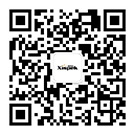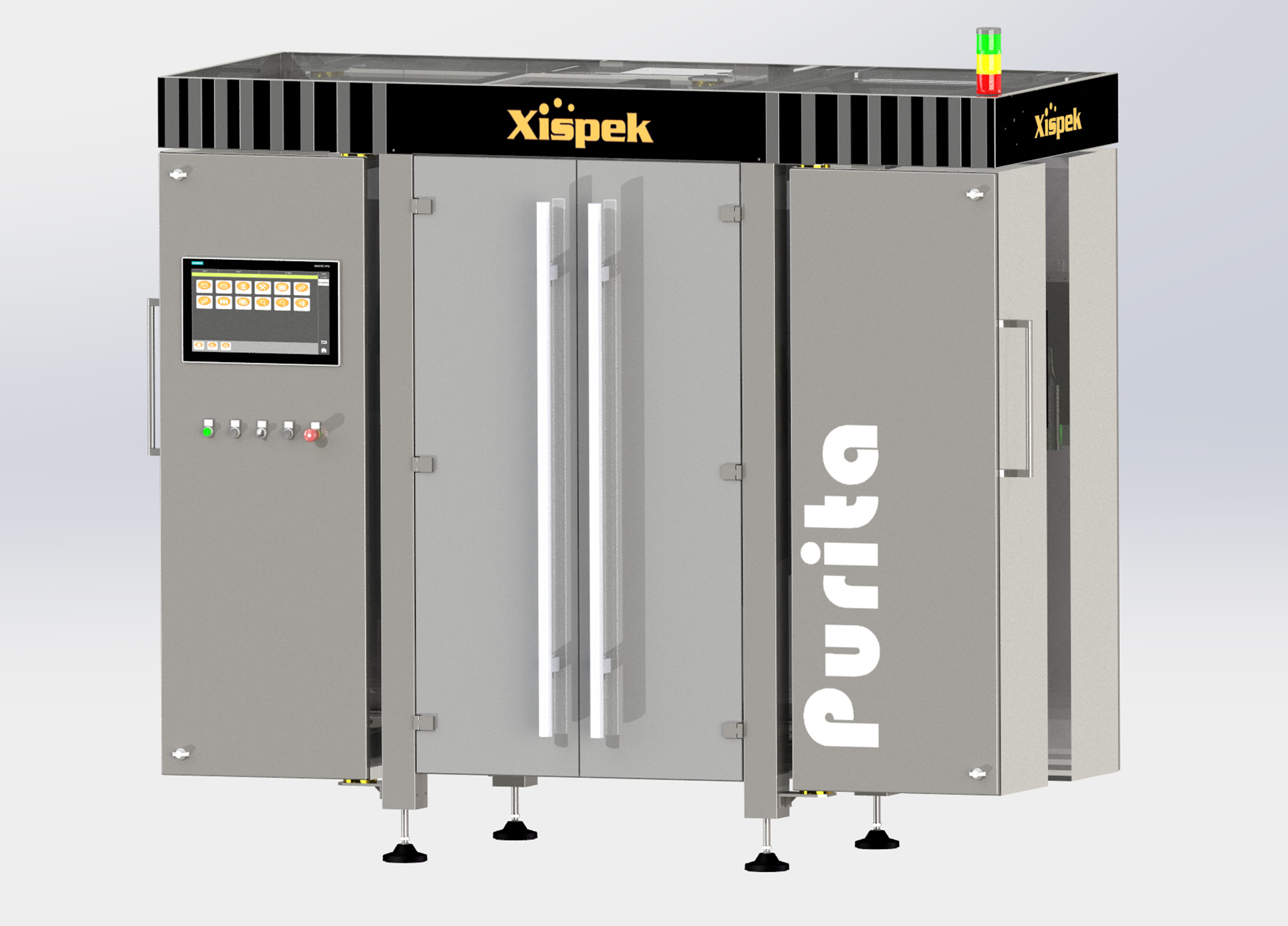
Empty bottle inspection machine is the most important testing equipment for all beer glass bottle production lines. Whether the bottles are recycled beer bottles or new disposable bottles, empty bottle inspection equipment is essential. The Purita Series of Empty Bottle Inspection Systems from Xispek is an online inspection machine designed to detect stains and defects on the bottle body, finish and base of the bottle on the production line. This ensures that beer bottles meet filling production standards prior to filling, minimizing customer complaints.
|
Scope of application:
|
Installation position:
|
 Bottle finish defects
Bottle finish defects
 Bottle body defects
Bottle body defects
 Bottle Thread Inspection
Bottle Thread Inspection
 Bottle base defects
Bottle base defects
 Bottle Inner Wall Inspection
Bottle Inner Wall Inspection
 Defects inside the bottle
Defects inside the bottle
 Residual liquid
Residual liquid
First of all, Purita Empty Bottle Inspection Machine is equipped with automatic rejection of shaped bottles. It is able to detect whether the shape of the bottle meets the standard requirements through advanced sensing or visual recognition technology. Once a shaped bottle is detected, the system automatically triggers a rejection mechanism to remove it from the production line, ensuring that only conforming bottles pass through and protecting the bottle inspection machine from damage. Secondly, the device is capable of detecting bottle finish breakage defects. It detects bottle finishes accurately through high-resolution cameras or sensors. If a bottle finish is found to be broken, defective or otherwise abnormal, to ensure product quality and safety. In addition, the empty bottle inspection machine Purita series conveying the glass bottle will be suspended in the air, through the principle of light transmission is also able to detect the bottom of the bottle dirty, foreign objects and other contamination, to reduce the risk of suspension and foreign objects after filling. The defects on the inner and outer walls of the bottle can be detected with either two or four bottle inspection modules, depending on the accuracy required by the customer. Each bottle inspection module is designed with polarized light and specular reflection for maximum viewing angle and image quality. By scanning and analyzing the entire bottle body, dirt, foreign objects or other defects adhering to the bottle wall can be quickly and accurately detected. Finally, the Purita series also includes a module for detecting residual liquid inside the bottle, which is able to readily identify even the slightest bit of bottle washer lye inside the bottle.
Xispek's Purita series of empty bottle inspectors is capable of inspecting 60,000 bottles per hour. In short, the Purita empty bottle inspector is a powerful machine that effectively inspects both recycled and new bottles for a wide range of defects. Its high precision inspection and sorting rejection capabilities ensure that products comply with standards and meet customer needs and expectations.
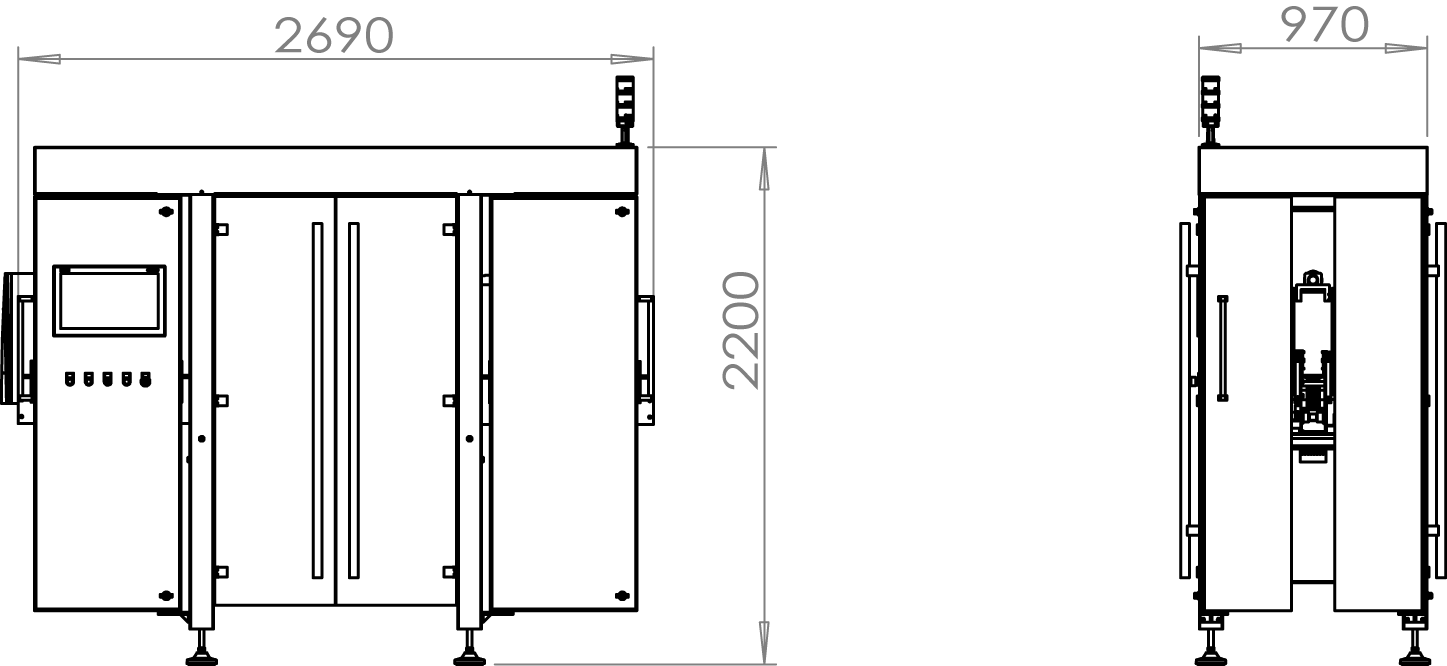
 Adopts XispVision® universal inspection software platform
Adopts XispVision® universal inspection software platform
 Linear structure, high inspection efficiency and inspection accuracy
Linear structure, high inspection efficiency and inspection accuracy
 Hygienic design for various environment
Hygienic design for various environment
 Four speeds, two outside wall modules optional
Four speeds, two outside wall modules optional
 Pre-screening system for shaped bottles
Pre-screening system for shaped bottles
● Sensor-based pre-selection module Selecta S
● CCD-based pre-selection module Selecta G
 Bottle Outside Wall Inspection Module
Bottle Outside Wall Inspection Module
● Dual Outside Wall Inspection Module S2
● Dual Outside Wall Inspection Module S2
 Finish Inspection Module
Finish Inspection Module
 Bottle Mouth Thread Inspection Module
Bottle Mouth Thread Inspection Module
 Base Inspection Module
Base Inspection Module
 Residual lye Detection Module
Residual lye Detection Module
 Control Center
Control Center
● Integrated Control Center X24
● Integrated Control Center X36
● Integrated Control Center X48
● Integrated Control Center X60
 Pusher
Pusher
● Pre-selection Pusher
● Contaminated bottle Pusher
● Damaged Bottle Pusher

The function of bottle inlet detection is to protect the bottle inspection machine from damage caused by those too high, too low, too large or too small bottles and fallen bottles.Those bottles should not enter the empty bottle inspection machine. Usually, photoelectric and proximity sensors can be used to detect bottles with cap, tall and short bottles and fallen bottles and to reject those unqualified bottles before entering the inspection machine. If those bottles with very little difference are mixed in the normal bottles, the camera based pre-selection system Selecta G is preferred. The Selecta G is based on the CCD camera technology which is more accurate to measure the shape of the shoulder or form curve of the bottle. the three sensors can detect tall bottles, short bottles and fallen bottles.

The Pre-selection system Selecta has the following features:
 Photoelectric induction type
Photoelectric induction type
 Rejects high and short bottles to protect the machine from damage
Rejects high and short bottles to protect the machine from damage
 Simple adjustment, easy maintenance
Simple adjustment, easy maintenance
 304 stainless steel, sanitary grade design
304 stainless steel, sanitary grade design
When the bottle passes finish inspection module, the LED light flashes and the light shines onto the curved sealing surface of the crown cap of the bottle. With a specially designed LED with a reflective bowl shape, the light is reflected back to camera of the finish inspection module. when the camera takes a picture, it can get the reflected halo image of the reflective surface of the bottle finish. In order to ensure the stability of the image, an additional trigger sensor is installed before the camera to precisely control the trigger time of camera. The LED light source and the camera are installed in the upper position of the bottle finish. The bottle finish inspection module takes the photo when the glass bottle is clamped and rotated with the bottom overhanging. This overhanging position reduces the impact of reflections from the conveyor chain on the bottle finish surface.
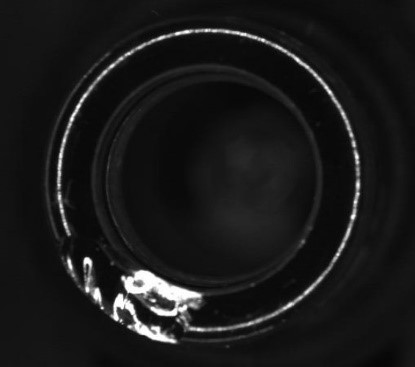
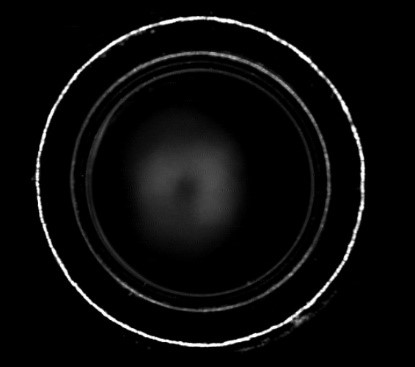
Under normal circumstances, the bottles identified as defective from the finish inspection module will be rejected by the first pusher because the bottle with a defective bottle finish does not have the value of recycling, The first pusher rejects the bottles directly into the trash bin. The rejected bottles will not sent back to the bottle wash machine for rewashing.
Finish Inspection Module has the following features:
 One high speed industrial camera
One high speed industrial camera
 Independent trigger sensor
Independent trigger sensor
 Maintenance-Free Bowl LED lighting
Maintenance-Free Bowl LED lighting
 Height adjustable for difference SKU
Height adjustable for difference SKU
 XispISP® image processing library
XispISP® image processing library
When the bottle passes through the base inspection module, the flashlight flashes, and the light reaches the bottle bottom camera through a specially designed lens system, The camera takes a picture of the bottle base as the light flashes. Then the image will be processed by computers to analyze the pixel gray scales in different areas of the bottle base to judge whether there are foreign objects, dirt and other defects on the bottle base. The polarized filters are also utilized on the bottle base inspection module, which can help to detect transparent films and cigarette packaging films. The special lens imaging technology is adopted to improve the visible area of the bottle base and to make the detection more reliable. Similar to the bottle inspection module, an additional trigger sensor is installed before the module to precisely control the trigger time of the camera to take pictures.

Under normal circumstances, the bottles identified as contaminated from the base inspection module will be rejected by the second pusher. The second pusher rejects the bottles to a rejection desk, and then transports them back to the bottle washing machine for rewashing.
Base Inspection Module has the following features:
 1 high-speed industrial camera
1 high-speed industrial camera
 Independent trigger sensor
Independent trigger sensor
 Maintenance free customized LED light source
Maintenance free customized LED light source
 Automatic air blow cleaning device
Automatic air blow cleaning device
 Height adjustable to accommodate different SKUs
Height adjustable to accommodate different SKUs
 XispISP® image processing library
XispISP® image processing library
Bottle Outer Wall Inspection. After the bottle passes through the bottle body detection unit at the bottle inlet end, it rotates 90ˇr on the bottle clamping belt through the differential speed of the two drive motors for clamping the bottle, and then detects it again at the bottle body detection unit at the bottle output end to achieve 360 Comprehensive detection. Xispek Empty Bottle Inspection Purita can provide bottle inspection modules in two arrangements, one is double bottle inspection module S2 (one bottle inspection unit at the bottle inlet end and one bottle outlet end). The other is the four-bottle detection module S4 (there are two bottle detection units at the bottle inlet end and the bottle output end). In terms of layout, the two bottle body detection units at the bottle inlet end and the bottle outlet end of the four bottle body detection are arranged opposite to each other, the purpose is to prevent the uneven thickness of the glass or the influence of the embossed pattern on the imaging, and the detection is more reliable. The unique spiral convex structure of the bottle body has a relatively large impact on imaging, and some defects are not visible at specific angles.
If a four-camera bottle body detection module is used, this effect can be basically eliminated due to its facing camera layout. Therefore, the four-camera bottle body detection module can improve the effect of bottle body detection, especially for the uneven thickness of the bottle body glass and the defects of the bottle shoulder, and the detection is more reliable.
A single outer wall detection module adopts mirror reflection, so that a single camera can obtain a larger field of view, so each camera can obtain images from two perspectives of the bottle body, as shown in Figure 3.6. The design of the outer wall detection module is also made more compact by means of mirror reflection.

Bottle inner wall inspection is particularly effective for semi-transparent bottles or bottles with external patterns. Using a single camera, it can detect foreign objects and contaminants on the inner wall of the bottle.

Under normal circumstances, bottles with defective bodies can be sent back to the bottle washer for rewashing, so in most cases, the second rejecter at the bottle outlet end removes them to the rejecting platform, and then transports them back to the bottle washer for rewashing.
Bottle Outside Wall Inspection Module has the following features:
 4 or 8 high-speed industrial cameras
4 or 8 high-speed industrial cameras
 360-degree dead-angle-free inspection
360-degree dead-angle-free inspection
 Maintenance-free customized high-brightness LED light source
Maintenance-free customized high-brightness LED light source
 Blocked bottle fast discharge
Blocked bottle fast discharge
 XispISP® image processing library
XispISP® image processing library
In terms of layout, the two thread inspection units at the entry and exit ends of the 8-camera thread inspection system are positioned opposite each other. This arrangement aims to mitigate the impact of uneven glass thickness or thread shape on imaging, ensuring more reliable detection. The spiral convex structure of the bottle mouth threads significantly affects imaging, and some defects may not be visible at specific angles. If an 8-camera thread inspection module is used, this impact can be largely eliminated due to its camera-facing layout. Therefore, the 8-camera thread inspection module enhances the effectiveness of thread inspection, particularly for detecting uneven glass thickness at the bottle mouth and defects on the front side of the bottle mouth, making the inspection more reliable.


The detection of residual lye adopts the principle of high-frequency electromagnetic field. High-frequency sensors consist of a transmitter head and a receiver head. They are installed on opposite sides of the conveyor belt. The transmitter sends electromagnetic waves through the bottle. On the other side, they are detected by the receiver. The analog measured values are transferred to the PLC, which supplies them to the evaluation computer. The measuring principle is based on the physical fact that when free ions come into the field of influence of an electromagnetic field, they couple with the electromagnetic field. This results in an amplification of the field. This amplification can be
measured and evaluated. Some liquids, especially lye, contain free ions. The recorded measurements of an empty vial can be represented graphically as a bell curve. If it contains lye, the electromagnetic field is amplified due to ionic coupling. The bell curve becomes steeper.
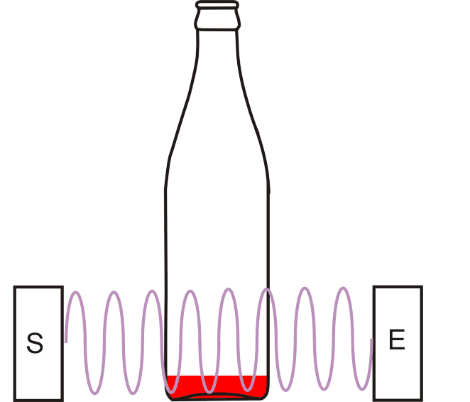
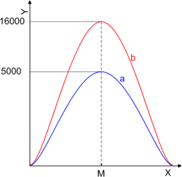
Under normal circumstances, due to the residual lye defective bottle can be sent back to the bottle washing machine for rewashing. So in most cases the second pusher rejects them to a rejecting desk, and then transports it back to the bottle washing machine for rewashing.
The Xispek empty bottle inspector Purita comes standard with 3 rejectors. A pneumatic rejector is installed after the screening system to remove unqualified bottles to the garbage truck; The other two are installed after the bottle inspecting machine, and a pneumatic rejector is installed on the single-row conveyor belt at the exit of the bottle inspecting machine. It is used to remove bottles with finish defects to the garbage truck. A servocontrolled rejector is installed on the rejecting desk to remove bottles with contamination such on bottle outside wall, bottle base and residual lye.


